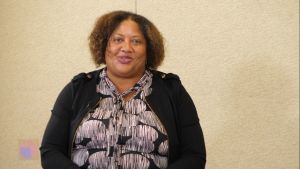Black women are the backbone of the American labor force, a narrative that begins with slaves toiling in the fields and homes on plantations during slavery. In Africa, motherhood was the primary role for Black women, but that changed when they were forced into labor and were required to put the needs of slave owners before their families.
“The legacy of slavery is to argue that Black women are somehow different from other women and to overlook the household and caregiving needs that black women have,” says Nina Banks, Associate Professor of Economics, Bucknell University. “During the period of slavery, Black women were expected to work in the fields, to work in the household, or to work for other people. That has continued to this day where we get this idea that Black women should be workers.”
Black women’s labor has always been shortchanged. A 2009 research report estimated that the present U.S. value of slave labor is as high as $14.2 trillion. Today, Black women are still struggling against pay inequality and discrimination in the workplace.
Black Women Enter the Workforce
During the post-slavery Reconstruction period, discrimination locked newly freed Black women out of jobs. Without options, a majority of Black women were relegated to domestic positions.
“It was difficult for them to get any other type of work as a group,” Dr. dt ogilvie, Professor of Urban Entrepreneurship & Economic Development at the Rochester Institute of Technology and a member of the Ph.D. Project said. “As a domestic, they faced not only racial discrimination, they face sexual discrimination. They were always in jeopardy if they said the wrong thing. They could be lynched. They were in a very precarious and unfortunate position.”
In 1866, only one year after emancipation, Black women formed the first labor union in Mississippi — The Washerwomen of Jackson.
“The white unions refused to allow Blacks, particularly Black women, so Black women formed unions,” says ogilvie. “Gender and racial discrimination were very much alive when white women started going to work. Black women were used as domestics to enable them to do that in many cases. Over many years, Black women activists have tried to fight for better wages and better working conditions for Black women in particular.”
Lucy Parsons, who was born into slavery, was a union organizer who supported the rights of female workers of color. In the early 20th century, Nannie Helen Burroughs helped launch the National Association of Wage Earners, an organization that advocated for the rights of domestic workers.
Black Women as Breadwinners
Dating back to 1870, Black women participated in the labor force on average three times more than white women. By 1880, more than 73% of single Black women were in the labor force.
Research indicates that poverty and lack of education after slavery contributed to more Black women participating in the labor force compared to white women, a phenomenon that still exists today.
“Black women have always had higher participation rates out of economic necessity,” says Banks. “If you go back to the late 19th century, Black women were in the labor force as domestic workers and agricultural workers because their families needed their earnings.”
Banks says the 1970s was a critical turning point for the instability of Black Americans.
“Structural changes in the economy, such as deindustrialization and the decline of unionized manufacturing jobs hurt Black men, especially those who lived in urban areas,” she says. “There’s job loss for Black men as we saw the beginning of mass incarceration through the war on drugs — Black men were disproportionately affected by that.”
Also in the 1970s, Banks says African American marriage rates started to decrease. Today, more than 80% of Black women are breadwinners, more than any other racial group.
“African American women – because of discriminatory treatment against Black men and also because of the discrimination that they face in labor markets – are carrying the heavy burden in trying to support children sometimes alone,” she says.
“The effect is that it’s very stressful. Not only are they responsible for financially supporting their household when they are lone parents, it also means they have to do all the work caring for children, as well as increasingly elder care.”
Black Women and the Wage Gap
The origins of the racial and gender wealth gap can be traced back to historical discrimination, including slavery and segregation. Black women are more likely than white women to work in low-paying service and production jobs with limited mobility, exacerbating the wealth gap. The Department of Labor estimates in 2019, Black women lost more than $39 billion because of the divide.
“Why that is significant is because that also adds to the precarity of Black households and the difficulty that Black families have withstanding periods of job loss, or even low wages, because there’s less of a cushion there,” says Banks.
Black women make 64 cents for every dollar a white man earns, bringing in $40,500 annually on average. It took until September 21 of this year — on Black Women’s Equal Pay Day — for a Black woman’s earnings to match up with what a white man made at the end of the previous year. Despite having the same level of experience as white men in the same job, Black women are most likely to be paid less, and as they progress in their careers and become more educated, the pay gap becomes larger.
“Even though more women are getting better jobs, there’s still a large group of women who aren’t,” says ogilvie. “Sometimes women forget about the fact that other women are still facing the same kind of challenges that historically Black women have faced.”
To shrink the wage gap and improve the economic outlook for Black women, Banks says the minimum wage needs to be increased.
“Black women are disproportionately likely to be minimum wage and sub-minimum wage workers,” she says. “We need to have minimum wages that are higher, that are livable and that are adjusted to changes in the cost of living.”
Banks adds that companies need to add benefits like subsidized childcare and increase pay transparency policies and enforcement tactics to combat the discrimination that Black women face at work.
Black Women and the Struggle for Equality
Black women are highly ambitious and are more likely than white women to say that they are interested in becoming top executives. Yet, Black women are underrepresented in leadership roles and are less likely to receive the support they need to thrive. They also encounter discrimination like microaggressions in the workplace. The feelings of burnout are real.
“The amount of pressure Black women face in the workplace — not having advocates because we’re the only ones, people don’t want to stick their necks out, people don’t recognize it or they are being the aggressors — the stress is tremendous,” says Kim Crowder, CEO and President of Kim Crowder Consulting.
Black women have not remained quiet. During the COVID-19 pandemic, they have spoken out by leaving the workforce in record numbers or venturing into entrepreneurship.
“We often find that Black employees, particularly women, are cycling out of organizations more quickly, but organizations are not questioning themselves around why that’s happening,” says Crowder. “That is where the work needs to be and organizations need an external partner to hold them accountable.”
Where companies, labor laws and policies fall short, Crowder says there are things Black women can do to advocate for themselves.
“Everyone doesn’t have the privilege of walking away from a job or saying no to a job offer,” she says. But for Black women who have that ability, Crowder suggests thoroughly researching a company online, the job position and the pay range. What are current and former employees saying? Don’t be afraid to negotiate compensation. She says a year and a half to two years is enough time to decide if the company is the right fit.
“I hope that Black women who want to be entrepreneurs — particularly those who can build their workplace culture and build their ability for asking prices for the work that they do — that they have more opportunities to do that in any field,” Crowder says.
“And for those in the workplace, I hope that they will not only be in a workplace where they can have equitable pay and equitable promotions, but where they can thrive,” she adds. “What I mean by ‘thrive’ is beyond this idea of the financial value, but around the quality of life overall.”
Watch sessions from Fair360, formerly DiversityInc’s 2022 Women of Color and Their Allies event here!
















